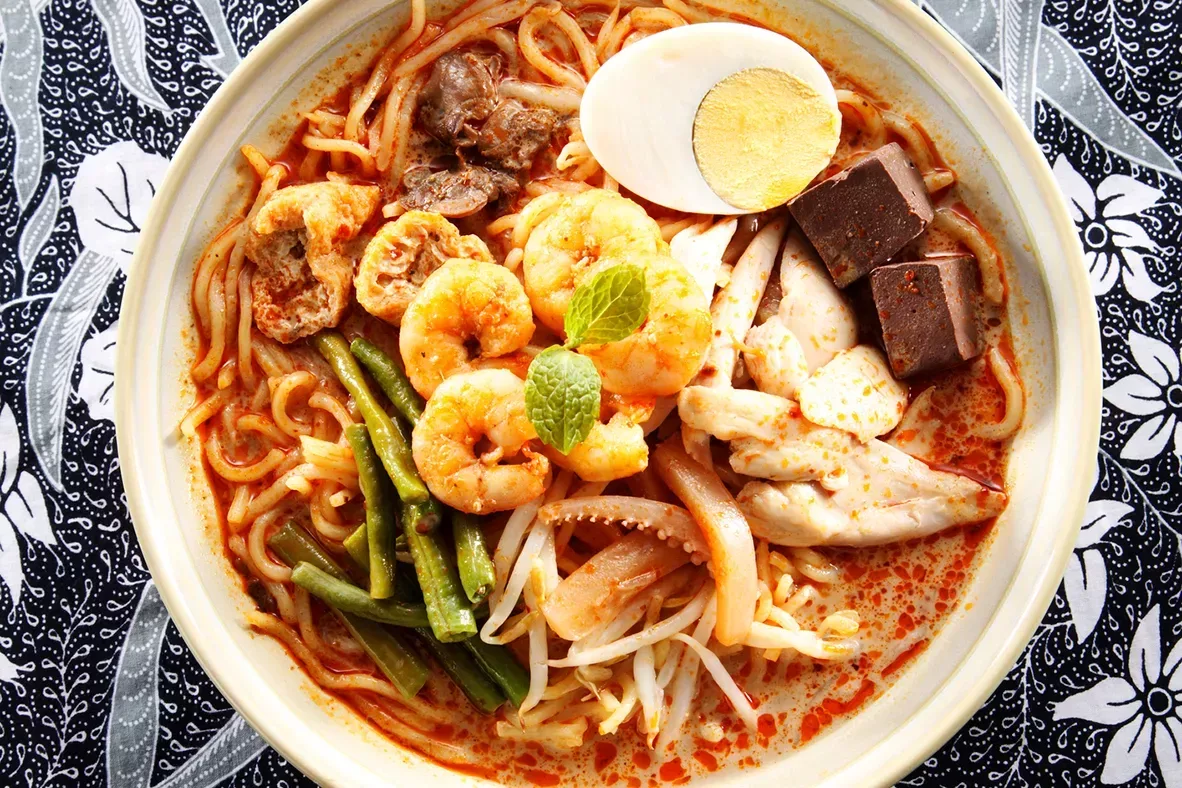From steaming bowls of Indian-influenced curry laksa to Chinese-inspired bah kut teh, Malaysian cuisine reflects its multicultural heritage.
Malaysian food reflects both the country’s multicultural heritage and distinct local ingredients. It’s the world’s ultimate fusion cuisine – not just east meets west but north meets south. Chinese, India, Sumatran and Thai influences fuse into Malaysian cooking. So, what dish best defines Malaysia?
Perhaps a bowl of curry laksa contains the very DNA of Malaysian cuisine. This noodle soup features fish and prawns from Malaysia’s elongated coast, which is warmed by the Andaman Sea. Chicken too. Stop at a rural village of kampong houses with long, sloping roofs and you’ll find countless chickens clucking around, soon to be oven ready. The soup is spiced according to southern Indian traditions, with turmeric, fenugreek and cumin. Meanwhile, the noodles, luxuriating in the thick yellow laksa soup, were probably introduced by Chinese immigrants.
As well as pulling together flavours from across Asia, curry laksa also represents Malaysia’s social diversity. A bowl of laksa is Malaysia’s zinging, unpretentious street food, simply ladled out from a cauldron on a battered van. Or moving upmarket, in a restaurant with dark-wood colonial elegance, the laksa may be served in a fine china dish, accompanied by spicy sambol and yet more sliced chilis.
Even the most patriotic of Malaysians would be hard pressed to identify a distinctive national dish. Some make a case for beef rendang, slow-cooked overnight from a complex recipe including red chilies, lemongrass, galangal, star anise, kaffir lime leaves, asam kandis and more. The slow cooking process produces a dryish, aromatic dish mainly served with rice or roti. Rendang – often eaten by Muslims at weddings or at Eid-al-Fitr, the feast following Ramadan – symbolises patience, sincerity and wisdom. Yet food historians argue that rendang, journeying from India via Sumatra, did not arrive in Malaysia until the 1900s.
Another Malaysian favourite dish, the “rojak”, sums up a nation that, as a colloquial translation says, is “a right mixture”. A rojak is a mixture of fruits and vegetables – and sometimes fried bean curd or hard-boiled eggs – often served with a spicy, palm sugar dressing. It’s a dish that reflects multi-ethnic, multi-religious Malaysia.
Even teh tarik, “pulled tea”, Malaysia’s national drink, appears elsewhere throughout Southeast Asia. Order a cup of teh tarik and you will witness performance art – the tea is poured from one jug on high to another to cool, aerate and froth. Originally, the condensed milk and heaped teaspoons of sugar were added to provide energy for those labouring hard.
No discussion of Malaysian food would be complete without mention of the controversial durian. It’s the foul-smelling fruit that divides families and is banned in public places; Malaysia’s marmite. Most durians are now commercially farmed but the durian hunter, Asia’s version of the truffle seeker, still searches for wild fruit. These connoisseurs shake and sniff the fruit knowingly in their quest for the finest specimens, which may fetch up to 250 ringits (around $60.) It’s a creamy fruit which crosses boundaries. Served as a sambol with fermented shrimp paste and sliced chilli, it’s savoury. Dished up with ice cream, it’s a dessert.
Rice, the staple of so many meals, must feature in any discussion of Malaysian food. Paddy fields, with white egrets symbiotically picking flies off the back of water buffalo, are found around the islands. Rice is a black and white issue. Pearly grains are eaten with curries, while bubur pulut hitam is a sweet porridge made with black sticky rice.
Back in the 15th century, Melaka, some 120 miles south of Kuala Lumpur, was on one of the world’s great trade and spice routes. Chinese settlers married into Malay society to create Pernanakan cuisine. Bah Kut Teh, losing something in translation as meat-bone tea, is a classic Pernanakan stew of pork ribs spiced with cinnamon, cloves, fennel garlic and star anise.
In summary, Malaysian food tells the story of the country. In the north there’s a distinctive Thai influence of noodles, kaffir leaves and lemongrass in the fragrant rice that you tend to find as you move closer towards Thailand. Further south, you’ll find dishes influenced by southern Indian traditions – curries flavoured with curry leaves and tempered spices, eaten with a flatbread called roti canai – developed after thousands of Indian labourers were brought in by the British to work on rubber plantations.
Ultimately, Malaysian food represents the nation’s diversity. Whether it’s a snatched snack of chicken nasi goreng, a slice of durian on the go or restaurant fine dining, it draws on the heritage of many cultures. It’s no exaggeration to say that Malaysian food is one of the world’s most cosmopolitan and exciting cuisines; a diverse “rojak” which can’t be encapsulated in just one dish.




















